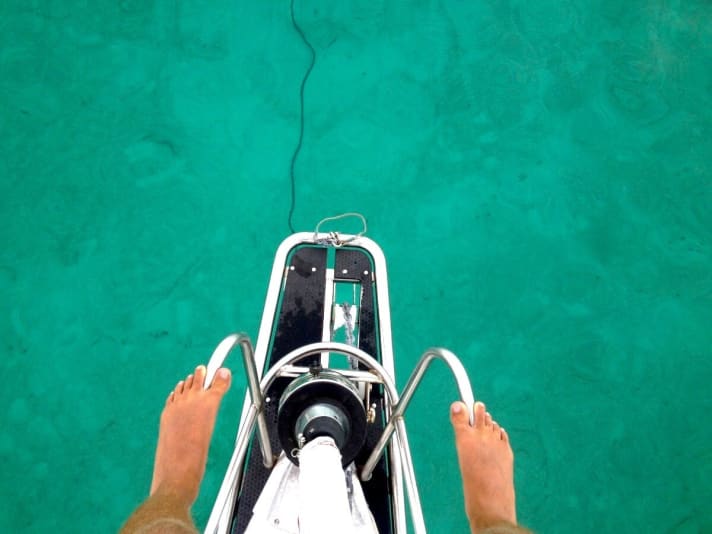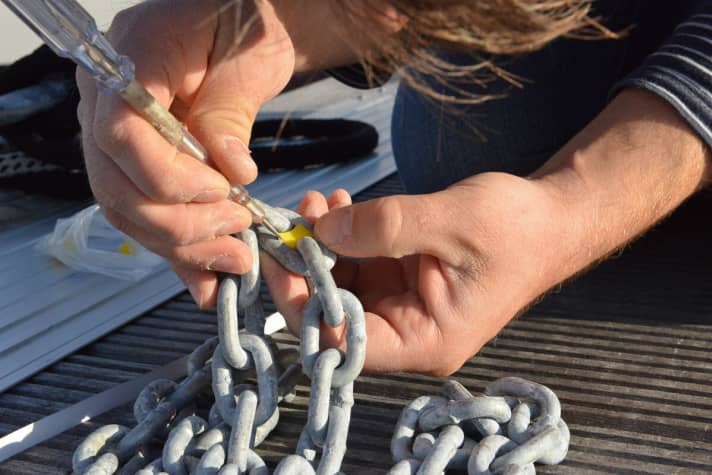
First times are usually moments that remain unforgettable. For example, I can still remember exactly what it was like to set sail alone for the first time. A few years later, driving a car alone. Many other "firsts": the first night at anchor (particularly impressive: being eaten by Mecklenburg mosquitoes), the first night on a new boat. The first time out of sight of land, then at some point the first mile of our great journey and the first island on the other side of the Atlantic.
I'm also aware that "first times" don't always have to be positive. But as an incorrigible optimist, I'm always quick to ignore such things. But then last week we had another such experience: the first time our anchor didn't hold.
We had spent the afternoon snorkelling on the wreck of the "Sapona", the old wreck on a reef south of the Bahamas island of Bimini. It had been built out of ferrocement at the end of the First World War (due to a lack of shipbuilding steel) and was then used as a floating liquor store and nightclub on Bimini in the mid-1920s. Until it was torn loose in a hurricane and finally found its final resting place here in the shallows. It has been an artificial reef for over 90 years and is home to thousands (not hundreds!) of colourful fish.

Although the day on the wreck was overshadowed by a grey sky, it could hardly have been better. The next morning, the wind was expected to shift to the south and increase enormously in strength, so we wanted to spend one last night anchored off the uninhabited island of Gun Cay before moving to the shelter of Bimini the next morning.
There is a light southerly wind as we motor into the shelter of the small headland in the middle of a beautiful sunset, drop the anchor to a depth of four metres, pull in the engine in reverse gear and put in 35 metres of chain. Anchor light on, pot on the cooker, end of work.
Our AIS transponder is one of the few devices on board that consumes almost no power (3 watts) and is therefore always running. Also so that our readers can keep us constantly track at Marinetraffic can. The low power consumption is mainly due to the fact that the transponder has its own small, monochrome monitor and does not need a plotter to display the ships around us. A nice gadget of the transponder is an anchor watch function that works excellently. You can set the radius within which the ship is considered "safe at anchor" and is allowed to sail. If it exceeds this radius, the transponder sounds an alarm.

Actually, you should set the anchor point as soon as the hook reaches the bottom. However, we always need a third person to do this, as Cati is on the wheel at that moment and I'm on the foredeck, dropping the anchor. That's why we always set the anchor point when the boat comes to rest. In this case, the anchor symbol marks the point at which the ship was once anchored. The transponder then uses small pixels to route how often and for how long we have travelled to both sides of the anchor position.
This is also the case that night. The anchor alarm is set, the alarm is armed. We crawl into our berth at around 11 pm.
Around midnight, the anchor alarm beeps me into the vertical for the first time. The wind has picked up and the boat has turned 20 degrees. Due to all the chain and a very tight radius setting, we have swivelled out of the circle. So I deactivate the alarm, set the radius larger, activate it again - and lie down in my bunk. Half an hour later, it beeps again. Same game, larger radius, back to the bunk. It repeats itself a few times. Routine check, everything is still OK. After all, we already have more than 100 anchoring nights behind us. 25 metres away from the anchor point, that's still okay. But the last time I sleepily forget to arm the alarm again. In the meantime, we have turned 80 degrees.
I wake up when I realise that the ship is lying at right angles to the waves. "Phew, the wind's giving us a good shove," I think. But the alarm remains silent. So it can't be that bad, I think. But I remain uneasy. Should I get up and check on things? Again? No more than 20 seconds pass before I hear a soft call from the lounge. My sister Susi has woken up. "Johannes? Is everything okay?" I jump out of my bunk, run to the chart table and look at the monitor: "136 metres." I rub my eyes and look again: "138 metres". That can't be right. "140 metres". Technical error? "142 metres". Human error! Then I realise what's happening: "Alarm! The anchor is slipping!"
Cati tumbles out of her bunk, Susi doesn't really know what's happening and just pulls her legs into her bunk so that we don't stumble over them in our haste, as if stung by a tarantula. "Start the engine," I shout to Cati and switch on our deck spotlights, which bathe the entire deck and cockpit in glistening LED light. Then I rush onto the foredeck, grab the chain and pull. No pressure. We are drifting. A glance aft. Ouch, the German cat "Cayluna", which was so far away yesterday, is getting closer and closer. It's difficult to estimate the distance because I can only recognise it by a white masthead light. I reach into the chain again and can feel the anchor dragging across the grassy bottom without reaching. A cartoon by Mike Peyton goes through my mind. It shows a crew on board their yacht wondering why their anchor isn't taking hold. Below the ship, you can see that the anchor has fallen into an old shopping trolley of all things and is rolling across the bottom.

My gaze jumps back and forth between our anchor chain and the large catamaran behind our stern. I'm slowly starting to think more clearly again. The island next to us is now on the other side than it was before we went to bed. So the wind must have shifted 180 degrees. That wasn't actually forecast until the morning, at least according to our two-day-old weather forecast. We must have drifted over our anchor and broken it out. This has happened before, and so far it has always dug itself back in quickly. The lights are just coming on on the cat behind us. Did they hear us? Or did they also realise that the wind shift had come earlier than expected?

I still hear no engine, feel no vibrations. "Where's the engine? We don't have much time!" - "The engine's running!" Cati yells back against the wind. - "Then put it in gear and step on the gas!". It takes what feels like minutes, probably only seconds, for the boat to react and pick up speed. I press the button on our anchor winch, which immediately starts to collect the chain. The cat behind us gets smaller. We head to windward. Puuuuuuh. That was close.
After the mark on the transponder, we find our old anchorage again despite the new moon, drop the anchor again (this time in the right direction of pull) and put in the chain. 30 metres. Oh come on, 40 metres. What the heck, 50 metres. At some point it "clicks" and all 60 metres are out. It doesn't matter. Just be able to sleep peacefully.
We switch off the deck light and reset the anchor point, then head down to the cabin out of the fresh, cold wind. Cati on the L-shaped sofa, Susi on her bunk, me on the engine hatch. Manoeuvre critique at half past two in the morning. "That was ... interesting," says Susi, who is still trying to understand what just happened. Cati is somewhere between happiness, tears and exhaustion. "It was just about okay," she says. I go over the experience again in my mind. "We can actually be satisfied," I conclude. Even if it seemed that way, it didn't take three minutes for us all to get out of the bunk, open the sea valves, get the engine running, pull in the chain and head to windward."
What did we do wrong? Should we have always kept an anchor watch? Not really, because when we went to sleep it was almost calm. But at the latest when I realised that the wind was shifting earlier than forecast, it would have been time to make a cup of tea, grab a book and follow the change in the weather. "Don't rely too much on the technology," I write in the logbook and watch for a while to see if the anchor is now holding securely and the wind isn't picking up any further. After an hour, I am sure that everything is fine and lie down in my bunk. I'm sure this won't happen again.
Further information about the trip: www.zu-zweit-auf-see.de

